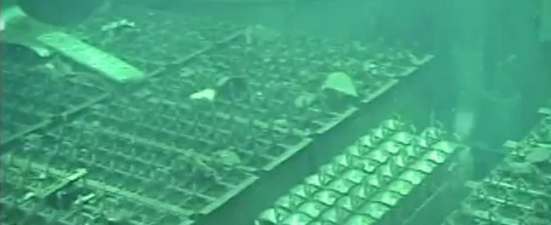Electricity problem at Fukushima Daiichi suspends cooling of spent fuel pools

Kyodo News reported on March 18, 2013 that a problem with electric power has occurred at Fukushima Daiichi nuclear power plant. This caused spent fuel pool units 1, 3 and 4 to be without fresh water which is necessary for cooling. According to the Nuclear Regulation Authority the incident, so far, has not affected the ongoing water injection to No. 1 to 3 reactors which suffered core meltdowns in the early days of the March 2011 nuclear crisis. TEPCO said the nuclear fuel stored in the pools will remain safe for at least four days without fresh cooling water.
As reported in October 2012, ground under Fukushima Unit 4 is sinking. During an interview in late 2012, Mitsuhei Murata, the former Japanese Ambassador to both Switzerland and Senegal, explained that the ground beneath the plant’s Unit 4 is gradually sinking, and that the entire structure is very likely on the verge of complete collapse. Many scientists say if Unit 4 collapses, not only will Japan lie in ruin, but the entire world will also face serious damages, Mr. Murata said.
Though it is really unclear how the situation will develop any bad news coming from Fukushima Daiichi nuclear plant stirs the negative feelings to the max.
- See live webcam of Fukushima Daiichi nuclear power plant here.
What would happen in prolonged interruption of spent fuel pools cooling?
Spent fuel pools contain fuel rods that have been taken out of a reactor core. Because they are highly radioactive, they continue to generate heat and must be cooled for years.
They also contain large amounts of radioactive elements, which can be released into the atmosphere if there is a prolonged interruption of cooling and the water in the pool boils off.
If the system that circulates and cools the water in the spent fuel pool stops working, the rods will begin to heat up the water in the pool and cause it to begin to boil away. If the water that boils away cannot be replaced, the water level will drop, exposing the rods. The rods will begin to heat, which can lead to damage of the rod, or possibly a partial or complete meltdown.
All of those consequences would lead to a release of radiation from the damaged rods. The amount released would depend on the severity of damage to the rods, the amount of spent fuel in the pool, and the length of time the rods have been in the pool.
Two of the radioactive gases released from fuel rods are iodine-131 and cesium-137. Because radioactive iodine-131 has a short half-life (eight days), it begins to decay quickly once the fuel is removed from the reactor core—so radiation releases from spent fuel will have much lower levels of iodine-131 than releases from the reactor core. However, cesium-137, which has a longer half-life (30 years), decays much more slowly, so levels will remain high in the spent fuel. Cesium-137 contamination from the Chernobyl accident was the main reason authorities had to establish an exclusion zone around that reactor. – UCSUSA – Nuclear Crisis in Japan FAQs

Dear Toad, I hope that that is web name and you haven’t already mutated?
The media and politicians are playing down the threat of the number four plant collapsing.
If it does, North America will be uninhabitable within a week, the northern hemisphere within a month. The world within six months, this could literally be an ELE (extinction level event) for all living creatures on the planet.
Have a nice day.
Fukushima is without doubt the worst ecological disaster in human history!! This didn’t stop once the fuel left the reactors in what is known as china syndrome. It will keep giving as time goes on. Your children’s children and there children will only see the beginning of this man made nightmare! The spent fuel pools might speed things up just enough for us parents & grand parents to witness the side effects that greed from very few will have gifted our future generations (if any?). One thing really strikes me as odd though…….
once all is lost and there is no more, how will these corporations & there Ceo’s keep there control & power over man kind? They surely must realise that without us there is no THEM! Either these people at the top are numb or extremely dumb?
ANGRY!!!
A question to the few & there supporters.
What will you tell your diseased and mutated children around the camp fire?
Answer- My greed is what got you all this kids! Don’t forget to take your pills and remove any loose teeth before going to bed.
Any man would feel proud!